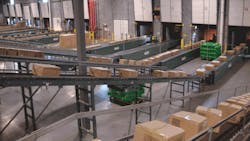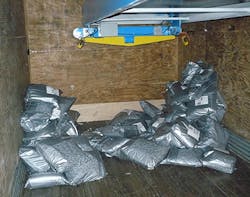Truck loading and unloading make the dock one of the most hazardous areas in a distribution center. Forklifts move in and out of trailers, possibly on an incline over a ramp, and lighting is generally poor inside trailers. On top of those things, trailer creep can result in forklift accidents, potentially causing serious injury to operators and devastating damage to equipment.
The need for speed and efficiency to meet shipper and carrier scheduling goals can accentuate these dangers. Trailers must be loaded and unloaded quickly and product sequenced “last in, first out.” These operations can be labor intensive as pallets stacked with parcels are brought into trailers on pallet trucks or forklifts and then items manually removed from pallets and stacked on the trailer floor. Unloading can be equally manpower intensive as parcels have to be stacked on pallets and shuttled out of trailers via pallet trucks or forklifts to be inducted into receiving operations.
In short, dock operations can be the bottleneck in any supply chain if not properly managed.
Need to Modernize
The loading dock is one of the last frontiers for systems modernization and efficiency in today's distribution centers. Solutions addressing its safety and productivity challenges have been available for some time and are now becoming more popular with the high-volume shipping operations of e-commerce retailers. One of the more easily doable actions is to extend the powered conveying surface from the distribution center to the inside of trailers using telescopic conveyors.
Telescopic conveyors can eliminate the need for forklifts and pallet trucks to enter trailers because they bring product into the trailer to the spot where it is to be stacked. Telescopic conveyors are mounted on the loading dock floor and telescoped into the trailer without contacting the trailer floor, avoiding floor obstacles. Nor do they need to be steered as with rigid drive-out or gravity systems. While a trailer is being packed, the powered conveying surface is retracted as the telescopic conveyor retracts until the trailer is full.
Pick to Shipping & Receiving
Handling is minimized as product no longer needs to be transferred from the warehouse conveyor system to a pallet truck or forklift for loading/unloading. Packages stay on the conveyor system to the point where it is stacked in the trailer. Pick-to-ship is one continuous flow, with direct interface to sortation and shipping systems. Likewise for unloading operations, product is loaded directly onto the telescopic conveyor and inducted directly onto the warehouse conveyor system for processing and storage.
“Telescopic conveyors deliver the product to the trailer operator at an ergonomically accommodating height of 30 to 36 inches,” says Mark Hogan, vice president of operations for Flexible Material Handling (www.flexmh.com), one of the manufacturers of this equipment. “Coupled with a variety of optional features including hydraulic tilt, powered snout, or man-rider platform, the work load on the trailer operator is greatly reduced.”
Automatic Option
These conveyors can also be equipped with a customizable sensor package, for operator-free loading. Working with the customer's application team, the vendor's engineers can custom design the telescopic conveyor and its support equipment to meet site-specific requirements. They can also fine-tune the programmable sensor package to achieve an 80% to 95% fill rate based on product size and package type.
“E-commerce retailers have really gained efficiencies in their dock operations with autoloaders used in shipping operations,” Hogan points out. “The individual orders are quickly loaded in the contracted carrier's trailer (USPS, FedEx, UPS, etc.) and transported to the carrier's distribution center for follow-on shipment to the retail customer.”
Cost Savings
With telescopic conveyors, less dock area is generally required. Loading and unloading operations are faster, resulting in less time each trailer must remain at the dock. This can ultimately result in the need for fewer dock doors and therefore less equipment such as dock levelers, dock locks and sensors.
Forklift costs are also reduced as fewer of them are required for loading and unloading.
Then there are the savings resulting from safer dock operations, resulting in less chance of injury to humans and damage to dock equipment.
Finally, operations are seamless with less handling of the packages. This seamless flow enables adhering to one of the oldest rules in material handling: “Only handle it once.”
The market for telescopic conveyors will continue to grow as developing economies seek alternatives to offset growing labor and safety costs. Employee salaries and workers' compensation costs will continue to rise. Automating loading/unloading operations reduces the potential for errors in load sequencing for the destination, and minimizes the possibility of injury and interrupted supply chain flow.
Alan Will is president of PWG Distribution Solutions, LLC (www.pwgds.com), specializing in analysis of logistics requirements for small and medium-sized firms. He is also a member of MH&L’s Editorial Advisory Board.


